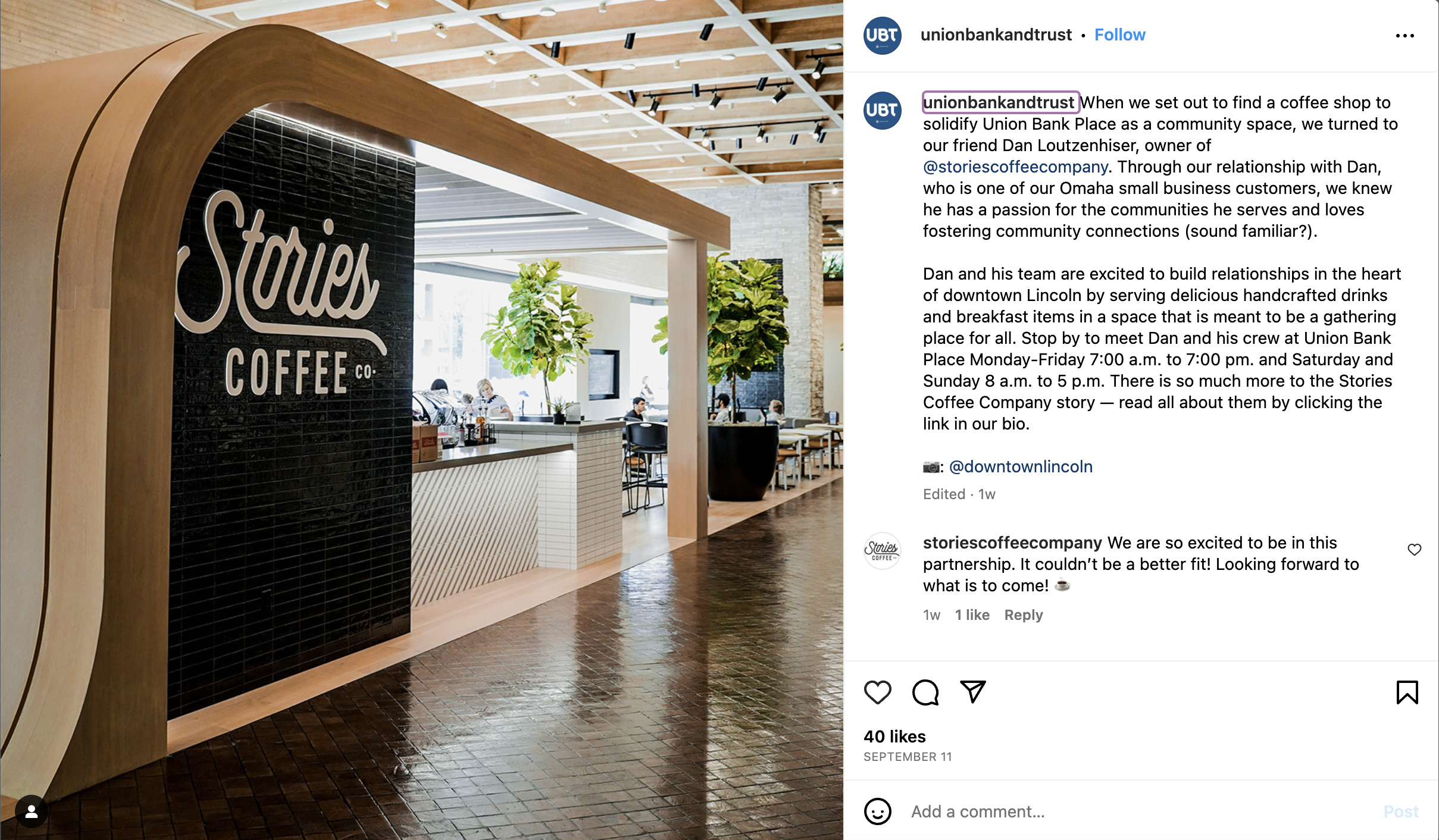Community banks, credit unions, and financial brands have a distinct advantage: they actually know their customers–often working with them for decades as their lives change and needs evolve. They become part of major milestones like buying a first home and starting a business. And when things get tough, they may even be involved in creative solutions that help people overcome difficult circumstances.
When it comes to translating those relationships into meaningful marketing efforts, businesses often make a misstep here. They assume a testimonial from a client about how great their organization is will do the trick. Those are great, but the most effective marketing goes a step further to tell customer stories in a way that highlights them–and how their lives have been impacted by the work your organization does at a personal and emotional level. Indeed, the way people feel when they bring a problem, challenge, or opportunity to your organization is the piece most relatable to your potential customers. It’s the point in time where they see their own situation in the stories you tell, and reach out for help.
Marketers have the unique role of uncovering and sharing those stories, and when they do, they’re able to tap into emotions in a way that is attention-grabbing and memorable. What’s more, highlights with emotional impact prompt people to take action. Here are seven easy ways to make sure your customers are front and center on social media in a way that makes people feel something!
@flagshipbank Cookies, caramels, and chocolates – oh my! #eatlocal #chocolateshop #sweettooth #handmade #minnesotabusiness #candy ♬ Good Time – Louis La Roche
Show Off Your Customers’ Businesses
Brick-and-mortar businesses you work with are a great place to start. Think about what will be engaging–a vet clinic with cute animals; a local nonprofit with a memorable mission; a flower shop with beautiful stems; a niche retail outlet hobbyists are especially fond of; a cozy coffee shop; a local theater company with an especially exciting upcoming production. Each of these has a story behind it–a person who saw the vision and needed capital to move it forward, and a member of your organization (or perhaps several) who worked with them to bring everything to life.
On social media, use photos or videos that capture the aura of the space, and provide a little history about how it got started, why, and by whom. Touch on the things that will resonate with loyalists, like the classic flavor at a local ice cream shop, the long-time teacher at a dance studio, or the local shop dog that lounges around an auto repair business. These fixtures make stories memorable, relatable, and interesting, drawing people in to engage and share. These types of posts do several important things: They show the community how much you care about your customers. They provide additional exposure that businesses will appreciate. They provide relatable content that taps into the memories and emotions of members of your community.
Post Special Moments
Financial brands have the unique perspective of being involved in some of the most exciting moments in people’s lives. Capturing those moments is a great way to convey the most human experiences your brand facilitates. It’s also a feeling many of your existing and future customers can relate to. Encourage lenders to capture a photo at the closing for their new home, when they break ground on a new build, or in front of the commercial space that will soon be their customer’s business in the flesh. Share them across your channels and via your lenders, telling folks a little bit about the people in the photos and all the emotions–joy, excitement, anticipation, nerves, relief–behind the photo. This strategy helps you tap into the emotions people feel at these high points, while also conveying your ubiquitous presence across your community.
Use Customer Quotes
The stats on testimonials and word-of-mouth marketing are staggering: Some 72% of consumers say positive testimonials and reviews increase their trust in a business and 88% of consumers say reviews influence their online purchasing decisions. You can use them on social media in two key ways: First, as graphics. Use your brand colors to show the quote visually. Keep it short–using the most impactful part of the quote in the graphic–and attribute the quote to the customer’s name with a little info about who they are (e.g. –Kathryn Smith, owner of Smith’s Furniture). Another way to use customer quotes on social media is to tie them back to more in-depth stories about customer successes, products, services, or other case study-style stories. This kind of long-from content will usually appear on your website (say, in a blog or news and updates section). Pulling a teaser quote from a customer that reflects an impactful moment into the caption for your social post helps stop the scroll, grabbing attention and enticing people to follow the link back to your website where they’ll keep reading.
Think about the stories you stop scrolling for in your newsfeed, and what encourages you to click on a headline to read the full story. Incorporate those tropes into your social content to direct traffic back to your website where potential customers can learn more about the relatable challenges a small business owner faced in getting her idea off the ground, or the series of events that led to a HELOC for a family facing an emergency.
View this post on Instagram
Capture Everyday Moments
Many community-focused financial organizations are pillars–deeply ingrained in schools, nonprofits, churches, business and civic leadership, and certainly in families. Oftentimes it’s the seemingly small moments that remind people of that consistency and fortitude. Like when a lost student showed up at a Nebraska-based bank branch near its city center and asked someone to call her mom; they discovered their bank was actually part of the family’s safety plan. Or maybe your branch manager ends up changing a tire in the parking lot for a customer or shoveling snow off the sidewalk after a particularly pummeling storm. Maybe a teller is helping a kid open her first savings account with all the change from her piggy bank.
These are moments people relate to–recalling their own memories and appreciating the dependability of a longstanding community fixture. Conjuring up these emotions is far more powerful than simply telling people that your organization is a longstanding community fixture. So, think about the stories you might recap at the end of your day at the dinner table with your family, and try to recognize them in real-time as opportunities to share the great work your organization does for its community on social media.
Share Case Studies
Approximately 25% of Americans say they don’t have anyone they can ask for trusted financial guidance! But, let’s be honest, most folks aren’t going to sit around educating themselves about SBA loans, CDs, HELOCs, and refi options for the sake of it. Extensive financial literacy content for your website or social channels might sound like a great idea, and there are ways to broach these subjects that can be engaging and entertaining, but what about a fundamentally more human approach? One that captures the sentiment behind these major strategic financial decisions? Case studies can do that, but it’s important to really tell the story.
Focus on the customer: What they were feeling, experiencing, and going through when they came to your organization for assistance. How were you able to help them work through it? How did it change things for the better? What’s that relationship like now? Once you unearth these stories (likely by working with your lenders and front-line staff to determine the best candidates), be sure to put them out through all your channels–website, social media, email, newsletters, even mailers. Use brief teasers to encourage people to click through and read the whole story on your website, effectively bringing traffic back to your website where you can capture their information and steward them as leads.

Publish Customer Interviews
Interviews are a great way to tell stories–especially if you don’t have the time or expertise to craft longer case study-style pieces. A Q&A format is also easier on the eyes, making people more likely to read it. To execute on a customer interview, reach out to your client-facing staff and try to pull together a quick list of customers who might be up for it. Narrow in on one that aligns with a product or message you’re trying to convey. From there, put together a handful of interview questions. Be sure to ask open-ended questions (that is, avoid yes-or-no questions). Start with a broad question about the customer’s background: Tell us a little bit about your background–where are you from? How did you get into this line of work? Then follow up with a more specific question that might speak to the inciting incident: What prompted you to consider building a new home on an acreage? Or perhaps: How did the idea to start your own business come to be? Use your third and fourth questions to ask specifically about the relationship with the bank, the specific financial needs the customer may have had, or the relationship they developed with your team. At the end of your question, always ask if there’s anything else they’d like to add; this provides space for the customer to open up about something special that you may not know to ask about.
Distribute Press Releases
News about happenings within your organization are a good way to conjure up interest in the work you do throughout the community. Be sure to publish these on your website, driving traffic back to your site from other channels like social media, customer emails, newsletters, and other avenues. Use press releases to announce big news like sponsorships, partnerships, mergers and acquisitions, technology upgrades, nonprofit work, internal leadership transitions, and other pertinent information.
It’s also a good idea to reserve press releases for major news from your customers, such as growth milestones, partnerships, sponsorships, and community involvement. Doing so provides ongoing support for your commercial and business customers, in addition to advancing relationships and positioning your brand adjacent to successful organizations.
Tell Real Stories about Real People
It’s simply not enough to say: We know our customers and we put them first. Tell us how, when, and why. Tell us about the moments–big and small–that show that commitment. What it ultimately comes down to is telling real stories about real people you work with.
Take the Next Steps
Showcasing your clients in your marketing strategy is certainly the way to go, but if your time and staff are limited, it can be especially challenging. If you’re ready to rethink the way you focus storytelling on clients to harness the power of emotion, but maybe aren’t quite sure where to start, Social Assurance can help.
Our client services team works with community banks, credit unions, and financial brands nationwide to build content strategies that center on customer stories and align messaging across channels so everything works together. This includes social media content, website content and SEO, and paid digital. It also includes training and content development services that connect lender and business development teams to marketing teams so messaging and execution move in-step. No time to put together the content or the strategy? Our team can handle that too.
Reach us directly at info@socialassurance.com or follow the link below to learn more.


